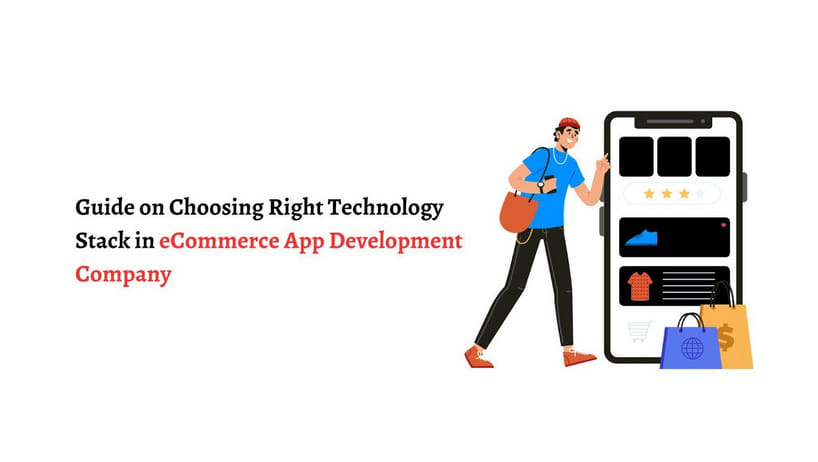In the ever-evolving sphere of e-commerce, designing a triumphant application is comparable to conducting a symphony, wherein each musical element must collaborate to engender a coherent and enjoyable interface for users. At the center of this virtual symphony is a technology stack, a compilation of programming languages, structures, and tools that sculpt the app’s capacities and ballots its competency in the demanding market. This blog guide analyses the procedures of opting for the salient technology stack for eCommerce app creation businesses, providing a blueprint and a thorough examination of the intricate technical details implicated.

As businesses endeavor to configure their online storefronts, the importance of technology decisions cannot be emphasized enough. Beyond an engaging user interface, the technology stack administration execution, security, extendability, and openness to future leaps forward. This guide is a essential for eCommerce pioneers, navigating them through the perplexity of frontend and backend innovations, security challenges, scalability measures, and importamce of collaborating with a specialized eCommerce app development company.
Understanding the eCommerce Landscape
- Types of eCommerce Apps
When deciding on a technology stack to deploy, it is important to select an option that matches the chosen business model, such as that of a single seller or a multi-vendor platform. It is beneficial to consider the salient features and requirements of these setups.
- Key Features and Requirements
Identify the necessary components, like product inventory control, secure payment portals, account validation, and implementation of orders, to adjust the technology stack accordingly.
Frontend Development
- Web vs. Mobile
The Internet, an indispensable part of our modern lives, has seen a revolutionary modification with the assistance of mobile devices in how we connect to the globe. We’ve acquired access to abundant materials with internet-dependent applications and sites, while mobile applications knacked a convenience, ease, and versatility that places them in a classification of their own.
As far as availability goes, web pages are up a river compared to mobiles – they can be accessed using any browser, regardless of technology, allowing for a far wider allotment. However, a more significant restriction raises its head with mobile applications, which are only reachable from specific operative systems.
Regarding user experience, mobile applications regularly possess a better constructed, proficient interface than sites recovered through browsers. Their layout and orientation are usually simpler, considerably quicker, and significantly easier to handle, which makes it far more straightforward to dive into and access features. What’s more, users of mobile apps have the extra advantage of on-location assistance and navigation functions.
Regarding portability, web pages can be evoked more quickly than exclusive apps. A demonstration of the power of applications comes from their convenience; you can take information and supplies wherever life may lead you, even far from the desk and your laptop.
Finally, each web and mobile application has advantages and disadvantages. Web readers grant a wide-range accessibility, while mobile tools grant a heightened practicality and usability. Based on the exact wants of a user and the available features and capabilities, either could be the ideal option.
Decide whether the eCommerce app should primarily be a web application, a mobile app, or an amalgam of a progressive or hybrid web app. While considering web frontend technologies, React, Angular, and Vue.js could be adopted. For mobile apps, one could opt for native Swift for iOS, Kotlin Java for Android, or cross-platform frameworks React Native and Flutter. Furthermore, Responsive Design would need to be taken into consideration.
- Responsive Design
Achieve a consistent user experience over all platforms with a responsive design. Utilizing CSS frameworks such as Bootstrap or Tailwind CSS can speed up the creation of a mobile-friendly user interface.
Backend Development
- Server-Side Programming
Choose a server-side language that jibes with the development squad’s familiarity and the application’s scalability prerequisites. Popular choices encompass Node.js, Python/Django, Ruby/Ruby on Rails, and Java—database picking.
- Database Selection
The selection between SQL (e.g., PostgreSQL, MySQL) and NoSQL (MongoDB, Cassandra) databases depends on the complexity of data relationships and the demands for scalability. APIs and Microservices are also factors to be considered.
- APIs and Microservices
Design a sturdy API architecture that enables connection between the front and back end. Contemplate embracing a microservices structure for scalability and sustainability.
Security Considerations
- Data Encryption:
Strengthen information transmissions using SSL/TLS protocols and link through HTTPS to encode data while moving—Encompass encryption strategies to protect confidential data stored in the collection and connect with Payment Gateway Integration.
- Payment Gateway Integration
Select authentic and reliable payment gateways like Stripe and PayPal, which offer robust Application Programming Interfaces for smooth and secure financial transactions. Make sure to carry out authentication verifications and authorize them properly.
- Authentication and Authorization
Consulting reputable authentication methods such as OAuth and JWT is suggested to guarantee safe user sign-ins. RBAC (role-based access regulation) should be set up to manage authorization suitably.
Scalability and Performance
- Content Delivery Network (CDN)
Integrate a CDN to enhance the app’s performance by delivering static assets from servers geographically closer to the user. Partnering with a professional eCommerce app development company help businesses accelerate the app performance with help of proven strategies and successful use cases.
- Caching Mechanisms
Implement caching strategies (e.g., Redis, Memcached) to optimize data retrieval and reduce server load, improving overall application performance.
Testing and Quality Assurance
- Automated Testing
Tap into examination architectures, such as Jest and Mocha, arrayed with supplies for computerized individual, amalgamation, and end-to-end testing to ensure the application’s dependability and immovability. Moreover, Load Testing should also be exercised.
- Load Testing
Utilize loading evaluation tools, including Apache JMeter or Gatling, to evaluate the app’s usefulness amongst different user scenarios and detect possible constraints and issues.
Future-Proofing and Maintenance
- Community Support
Choose technologies with active and supportive communities, ensuring ongoing updates, security patches, and access to a wealth of resources.
- Scalability Planning
Select technologies that offer scalability options to accommodate future growth, such as horizontal scaling and containerization with Docker and Kubernetes.
Conclusion
The importance of selecting the appropriate technology stack for eCommerce app development is immense due to its effect on the app’s efficacy, scalability, and overall success. This exploration, backed by tech mastery, emphasizes amalgamating technological choices with business goals, user satisfaction principles, and scalability considerations.
By progressing through front-end and backend creation, safety precautions, scalability mapping, collaboration with a professional eCommerce app development company and real-world examples, this guide functions as a navigational resource for eCommerce app builders starting their mission to design durable, future-proof, and top-tier applications. The diverse character of eCommerce necessitates an attractive interface and an enduring and extensively structured tech foundation. This foundation allows companies to triumph in the digital commerce sphere.




Click On The Given Link To Read More Such Posts.
https://getblogour.com/exposing-the-us9514961195221-package-delivery-scam/